 |
| San Cristobal Island |
It's very important that you know that it is a very personal journey I take with you in these pages. These enchanted islands have been my home and that of my family for three generations. They are, to me, a constant source of joy, mystery and delight. From childhood, I recognized that I lived in a wondrous and unique place. I am commited to imparting my knowledge and deep concern for the environment to my guests and, through this blog, have a chance to share my experiences with you. Come and share the world I love with me. For now, experience just a little of what the Galapagos Islands have to offer in this video from my good friend Alex at Aqua Surround.
The Galapagos Islands is, in so many respects, a study in contradictions and diversity. I tell all of my guests, "Expect the Unexpected."
 |
| Cactus on Santa Fe Island |
Charles Darwin himself noted his surprise at the moderate climate relative to the fact that the islands are situated on the Equator. He wrote, “[It] is far from being excessively hot…excepting during one short season, very little rain falls, and even then it is irregular.” He went on to explain why, stating, “[T]his seems chiefly caused by the singularly low temperature of the surrounding water, brought here by the great southern Polar Current.” As proved to be true about many things, Darwin was right.
Think of currents as rivers flowing in different directions and intersecting within the
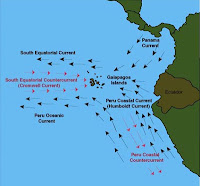 |
| Ocean Currents Map from The National Weather Service http://www.srh.noaa.gov/jetstream//tropics/itcz.ht |
Five ocean currents intersect at the location of the Galapagos Islands and have a profound impact on its climate and, accordingly, its flora, fauna, land, sea and bird life. The prevailing currents are Cromwell, Peruvian, Humboldt, and the Panama Current. The fifth current, El Niño, sometimes has a devastating effect as well. The weather at any given time is informed by and determined on the basis of the prevailing current. We even have seasonal climate changes here – all brought about by the ocean currents. The mix of these currents and the related location of each island causes a wide variation of water temperatures from month to month and island to island.
Humboldt Current
 |
| Galapagos Penguins Swimming in the Humboldt Current Photograph from Creative Commons by Lebatihem |
 |
| Fur Seal Photograph from Creative Commons by A. Davey |
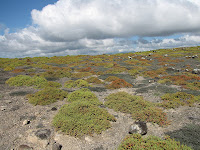 |
| Typical Cloud Covering on Santa Fe Island |
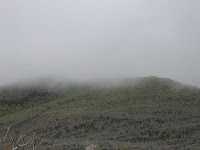 |
| Rabida Island Enveloped with Guara Photograph by David Tana at superoceras.blogspot.com |
Throughout the
Cromwell Current
.jpg) |
| Underwater Footage Showing Variety of Marine Life Made Possible by the Ocean Currents All Underwater Photos by Brian Postill |
The Cromwell is huge, extending the entire length of the equator in the
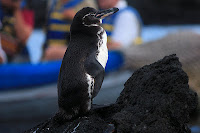 |
| Galapagos Penguin Photograph from Creative Commons by Hanumann |
The very cold Cromwell Current (just 13 degrees Celsius at its core) lies 300 feet underneath the surface current and is like a river flowing in the opposite direction. Because it is so high in nutrients and oxygen, the Cromwell Current supports a wide array of marine life. It is unusual for the Cromwell current to appear in the eastern Galapagos Islands. For the most part, it surfaces near the western islands of Fernandina and Isabela. Then, upon encountering the submarine Galapagos platform it dissipates toward the center of the archipelago.
.jpg) The Cromwell Current has a dramatic impact on the marine environment throughout the
The Cromwell Current has a dramatic impact on the marine environment throughout the
Recently a blogger wrote about his diving experiencing around Isabela Island in the Cromwell Current, where the water temperature is about 58 degrees F (16C). He identified varied and fascinating marine life that might be encountered in this nutrient rich environment: "Mola Mola that were very close to us ... seahorses everywhere, bull sharks, red-lipped bat fish, sea lions, flightless cormorant, schools of salemas, dozens of sea turtle, king angel fish, Mexican hog fish, harlequin wrasse, pompanos, and bonitos ... big marine iguanas eating under the water. After one of our dives we did a panga ride along the cliff where we spied penguins, flightless cormorants, marine iguanas relaxing, hunting and swimming, sea lions, pelicans, and resident blue footed boobies." More from this blog.
Panama

 The Panama Current is a warm water current that predominates from about November (the beginning of what we call the "wet" season) until May. The water temperature rises, the skies clear with the exception of occasional rain showers. The water during the period of the Panama Current is actually clearer because there are fewer nutrients concentrated in it. The marine life is very rich during this period as well. The warm water brings loads of schools of fish as well as sharks and rays.
The Panama Current is a warm water current that predominates from about November (the beginning of what we call the "wet" season) until May. The water temperature rises, the skies clear with the exception of occasional rain showers. The water during the period of the Panama Current is actually clearer because there are fewer nutrients concentrated in it. The marine life is very rich during this period as well. The warm water brings loads of schools of fish as well as sharks and rays.El Nino
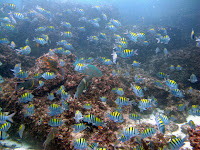 |
| School of Galapagos Island Fish Before El Nino Photograph from Sciencewithoutborders.org |
 |
| Iguanas Shrink in both weight and height without nutrition Photograph from Sciencewithoutborders.org |
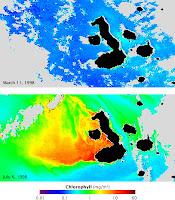 NASA has extensively studied the effects of El Nino on the Galapagos Islands. From a satellite, it photographed the amounts of chlorophyll in the water during and after El Nino. These satellite maps show chlorophyll concentration (which corresponds with the density of microscopic ocean plants, called phytoplankton) during El Niño (top) and La Niña (lower). Blue represents low concentrations, while yellow, orange and red indicate high concentrations. Currents that normally fertilize the phytoplankton reverse during El Niño, resulting in barren oceans. These same currents are strengthened by La Niña resulting in an explosion of ocean life. It doesn't take much to imagine that in periods of El Nino, when there is nothing left for the fish to eat, the fish must abandon the Galapagos for better feeding grounds, leaving the animal life that depends on them to seek alternatives and, sometimes, to become extinct.
NASA has extensively studied the effects of El Nino on the Galapagos Islands. From a satellite, it photographed the amounts of chlorophyll in the water during and after El Nino. These satellite maps show chlorophyll concentration (which corresponds with the density of microscopic ocean plants, called phytoplankton) during El Niño (top) and La Niña (lower). Blue represents low concentrations, while yellow, orange and red indicate high concentrations. Currents that normally fertilize the phytoplankton reverse during El Niño, resulting in barren oceans. These same currents are strengthened by La Niña resulting in an explosion of ocean life. It doesn't take much to imagine that in periods of El Nino, when there is nothing left for the fish to eat, the fish must abandon the Galapagos for better feeding grounds, leaving the animal life that depends on them to seek alternatives and, sometimes, to become extinct.The images from 1998 graphically show that the unique Galapagos ecosystem was severely affected and many species, including sea lions, seabirds, and barracudas, suffered a very high mortality level. However, during the second week of May, 1998, the ocean temperatures plummeted 10 degrees in one day, and the ocean productivity exploded with large phytoplankton blooms. Rapidly, many species recovered and the land species started to reproduce. Read more from NASA about the El Nino effect and the importance of the underwater plant life. There are photographs of the devastation that El Nino had on marine life, including sea lions and iguanas. During a period of El Nino the Galapagos National Park Service is diligent in following and studying all the animal, bird and marine life and providing human support to forestall harm to any species.
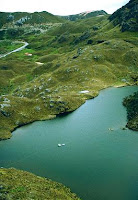 |
| Green Surface During El Nino Photograph from National Oceanic and Atmospheric Assn. U.S. Gov. |
Please let me know what you think about the posts and whether I can answer any other questions for you by commenting below or emailing me.

+public+domain.jpg)

.jpg)
Oh, I wish I was still there too! Loved this post – top-notch writing and fantastic images… and that goes for your entire site. Not many travel blogs are of this caliber. Thanks for sharing and taking me back to Santa Cruz.
ReplyDeleteThank you so much for your feedback. Please be sure to share my blog with others and, if you haven't already, like the Galapagos Eco-Lodge on Facebook.
DeleteThank you for this excellent post. I have just returned from the Galapagos, and wanted to be sure that I understood exactly how the currents affect the islands. This post was most helpful.
ReplyDeleteThis comment has been removed by a blog administrator.
ReplyDeleteThis comment has been removed by a blog administrator.
ReplyDeleteThis comment has been removed by a blog administrator.
ReplyDeleteThis comment has been removed by a blog administrator.
ReplyDeleteIn your articles I have learned much information about the Galapagos Islands. I've never thought that these islands have so many unique plants and animals.
ReplyDeleteGreat readd thanks
ReplyDelete